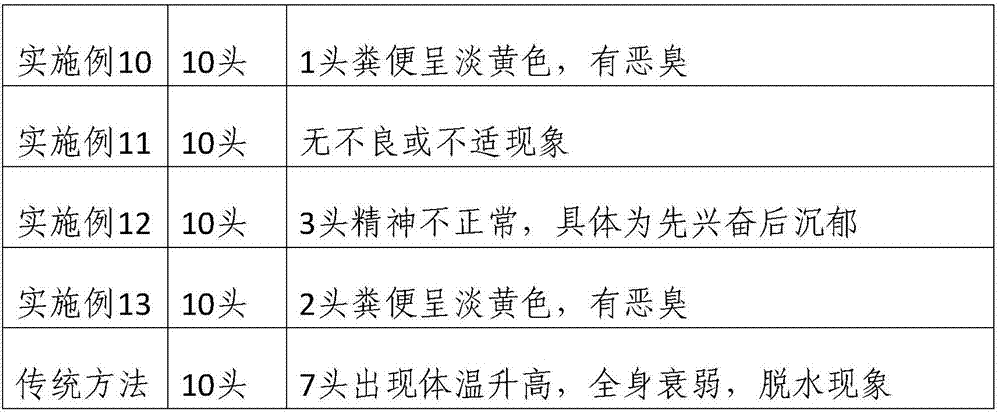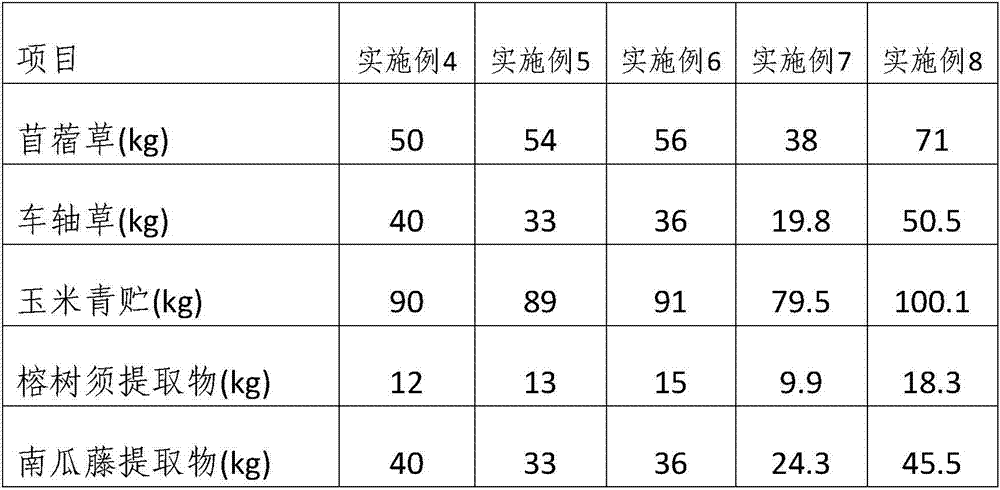Breeding method for beef cattle in calf period
A technology of beef cattle and cows, which is applied in the field of poultry and livestock breeding, can solve problems such as incomplete rumen development, high requirements for milk replacer preparation, and health problems, so as to improve the activity of anti-inflammatory factors, help digestion and absorption, improve Effects of Microbial Environment
- Summary
- Abstract
- Description
- Claims
- Application Information
AI Technical Summary
Problems solved by technology
Method used
Image
Examples
Embodiment 1
[0045] The feeding method of the young beef cattle provided in this example is to feed them separately from the cows after consuming breast milk for 5 days after birth. Feed, feed 3 times a day;
[0046] At the age of 30 days, add adult cattle concentrate feed, and limit the daily intake of concentrate feed to 0.3kg per head;
[0047] Wherein, be provided with the litter material that thickness is 40cm in the fermentation bed, in raising process, every 10d, spray lactic acid bacteria liquid to fermentation bed, then plow the litter 20cm deeply; The concentration of lactic acid bacteria liquid is 10 6 cfu / ml;
[0048] Litter is produced by:
[0049] 1) Weigh and mix the following components evenly: Flammulina velutipes 10kg, hawthorn 5kg, kelp 7kg, wax gourd 10kg, bitter gourd 17kg;
[0050] 2) The mixture in step 1) is piled up, the pile is 1.5cm high, and the yeast liquid is sprayed on the surface of the pile, and its concentration is 10 6 cfu / ml; ferment until the intern...
Embodiment 2
[0058] The feeding method of the young beef cattle provided in this example is to feed the cows separately from the cows after consuming breast milk for 7 days after birth. Feed, feed 3 times a day;
[0059]At the age of 30 days, add adult cattle concentrate feed, and limit the daily intake of concentrate feed to 0.6kg per head;
[0060] Wherein, be provided with the bedding material that thickness is 50cm in the fermentation bed, in raising process, every 10d, spray lactic acid bacteria liquid to the fermentation bed, then plow the bedding material 25cm deep; The concentration of lactic acid bacteria liquid is 10 7 cfu / ml;
[0061] Litter is produced by:
[0062] 1) Weigh and mix the following components evenly: Flammulina velutipes 20kg, Hawthorn 8kg, Kelp 15kg, Winter melon 30kg, Bitter melon 29kg;
[0063] 2) The mixture in step 1) is piled up, the pile is 1.8cm high, and the yeast liquid is sprayed on the surface of the pile, and its concentration is 10 7 cfu / ml; ferm...
Embodiment 3
[0071] The feeding method of the young beef cattle provided in this example is to feed the cows separately after consuming breast milk for 6 days after birth, and transfer the calves to a barn equipped with a fermentation bed for feeding, and feed milk substitutes every day Feed, feed 3 times a day;
[0072] At the age of 30 days, add adult cattle concentrate feed, and limit the daily intake of concentrate feed to 0.5kg per head;
[0073] Among them, the fermentation bed is provided with litter with a thickness of 45 cm. During the feeding process, the lactic acid bacteria liquid is sprayed to the fermentation bed every 10 days, and then the litter is deeply plowed by 25 cm; the concentration of the lactic acid bacteria liquid is 5 × 10 6 cfu / ml;
[0074] Litter is produced by the following methods:
[0075] 1) Weigh and mix the following components evenly: Flammulina velutipes 15kg, hawthorn 6.5kg, kelp 11kg, wax gourd 20kg, bitter gourd 23kg;
[0076] 2) The mixture in st...
PUM
 Login to View More
Login to View More Abstract
Description
Claims
Application Information
 Login to View More
Login to View More - R&D
- Intellectual Property
- Life Sciences
- Materials
- Tech Scout
- Unparalleled Data Quality
- Higher Quality Content
- 60% Fewer Hallucinations
Browse by: Latest US Patents, China's latest patents, Technical Efficacy Thesaurus, Application Domain, Technology Topic, Popular Technical Reports.
© 2025 PatSnap. All rights reserved.Legal|Privacy policy|Modern Slavery Act Transparency Statement|Sitemap|About US| Contact US: help@patsnap.com



